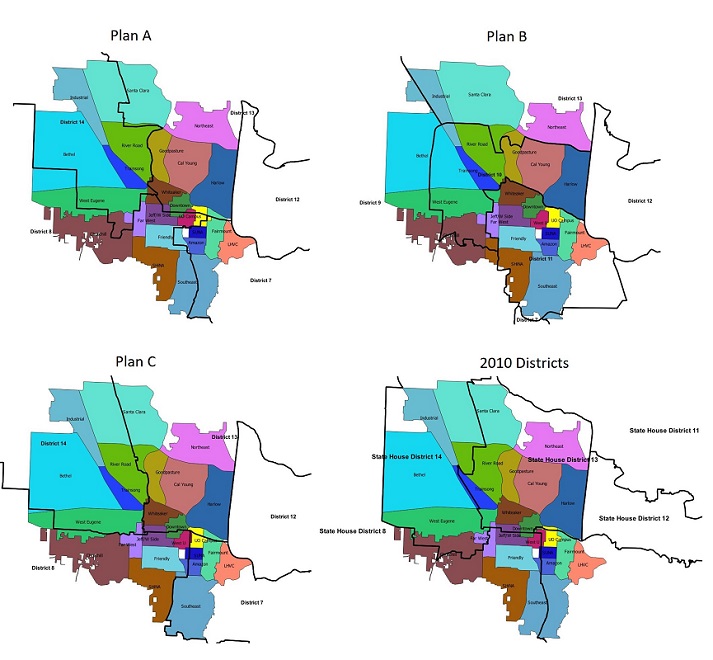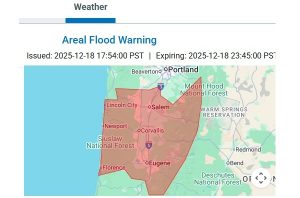Area residents oppose Plan A; ask that redistricting honor UO as ‘community of common interest’
6 min read
University-area neighborhoods through Friendly, Amazon, and Southeast would be divided under redistricting Plan A. The first hearing for area residents saw solid opposition to Plan A, and requests to adopt Plans B or C.
Area residents asked that communities of interest, such as the University of Oregon, be preserved in the new House districts.
[00:00:08] Lisa: My name is Lisa. My southwest community is very much within Eugene city limits. Changes in the public bus routes recently excluded my neighborhood, so commonly used driving and biking routes are very important to me – Hawkins Lane, Bailey Hill Road, 18th, 11th, 7th, as well as Delta and Randy Pape Beltline highways. House Plan B and Senate Plan A make the most sense to me. They do not split up parts of Eugene up as much, and they’re without so many of the strange jigs and jags in the main transportation routes that are listed on other maps. In addition, they incorporate and are mindful of the natural barriers and have some consideration to rural versus urban areas. Although it incorporates much of the more rural areas, House Plan C is a decent attempt to keep my community together.
[00:01:04] Lisa Fragala: My name is Lisa Fragala. I serve as a member of the Lane Community College Board of Education and the City of Eugene Planning Commission. As for the maps proposed for Oregon House districts, one of these maps does not serve my community’s interests or recognize the natural transportation or political boundaries that we live our lives in. Proposed Map A wiggles its way through my neighborhoods specifically right where I live and effectively divides a connected community, the Friendly Street Neighborhood. This community sends its children to schools together. It’s developed emergency response systems. It has very walkable development for business and recreation, and we celebrate together. We’ve worked hard to get through this pandemic together. It is in the best interest of this community that we have a single representative and not be divided by redistricting. Proposed Map C for our community of interest is a much better proposal. The lines follow street and natural boundaries that make sense for our communities and it doesn’t divide the University neighborhood into three pieces.
[00:02:16] Marie Bowers: My name is Marie Bowers and I live in the Coburg area. In 2011, I testified about how important it is to keep communities of common interest together, and yet we still ended up with a gerrymandered district. Even my current State Representative Wilde acknowledges that and already twice this year has testified saying the same thing. Legislative Plans A and C do not work and are the same gerrymandered stories, with just different lines. There are several other options, some on OLIS, like House Plan B, and like the one I drew, that keep within natural boundaries. Any time you mix urban and rural in our district, rural loses. The legislature needs a balance of voices, not just the ones that were majority wants to hear.
Thank you for supporting
local citizen journalism
[00:02:53] James Jacobson: My name is James Jacobson. I’ve lived in west Eugene now for about 14 years and I’ve lived in Lane County for 26 years. I am in support of House and Senate Plans C. These maps make more sense to me on how communities of interests are kept together and also take into account transportation link shopping, and other natural boundaries. I do much of my shopping along West 11th and River Road area. I also liked that the city of Springfield, where many of my past coworkers from the University of Oregon are living that it should be kept intact into a single House district, which is important to those citizens.
[00:03:39] Blake Helm: My name is Blake Helm, president of AFSCME Local 2238. I currently live in Springfield, I am supportive generally of the House Plan C maps that your committee has proposed a few days ago. They preserve some important communities of interest located in and around Eugene and Springfield. Specifically, they preserve the University of Oregon as a community of interest, which ensures its effective representation and also preserves the city of Springfield as a community of interest, allowing for residents like myself to elect candidates who are supportive of the city as a whole. That said, I am disappointed that more was not done to accommodate a significant and important community of interest in the area: survivors of the Holiday Farm Fire. The proposed House Plan C map does not keep this community together. The split between the House district 13 and 7 will divide this community, preventing the families and small business owners who were impacted to elect their candidate of choice, one who will be responsive to their needs as they work to recover and rebuild from tremendous losses.
[00:04:43] Becky Garvin: My name is Becky Garvin. I’m here to speak as a citizen who cares about our Duck community. I request that the redistricting committee preserve the University of Oregon community as a community of interest when y’all finalize the House and Senate district lines. One proposal in particular, Map A would divide our university campus in three, placing the west portion of the campus in one house in Senate district, the eastern portion into another, and the northern portion into a third House and Senate district. It’s difficult for me to imagine a legitimate reason to split the university community, or any community with shared interests like ours in this manner.
[00:05:35] Robert Melnick: My name is Robert Melnick. I have lived in Oregon for 40 years. I’m professor emeritus at the University of Oregon, where among other positions, I served as Dean of the School of Architecture and Allied Arts for 10 years. I currently direct a research group that brings in hundreds of thousands of dollars each year in grants from federal agencies, supporting faculty and students, and significantly contributing to the local economy and the University’s national and international reputation. As I know you all recognize, the University of Oregon contributes in so many ways to the well-being of Oregon and the citizens of our state…
The University is an important community of interest that should be preserved in redistricting to ensure effective representation. Although we are, and really rejoice in being a diverse institution, we do have common interests that deserve consistent and unified representation in Salem. The proposed Map A divides the University into three different House districts and three different Senate districts, exactly what the redistricting law seeks to avoid and seeks to prevent. Map A will not serve the University or the people of Oregon well. I strongly support Map C, which preserves the University as a community of interest, and ensures its effective continued representation in both the House and the Senate.
[00:06:58] Jerry Rosiek: Jerry Rosiek. I’m a professor at the University of Oregon and a member of the Faculty Union Bargaining Team, so I get to talk to a lot of my colleagues, and members of the other professional unions on my campus, so I have a better sense than I otherwise would have of the sentiment on the campus. And the University of Oregon is a community of interest, if anything is. Our institution and all of the businesses and livelihoods that are impacted by state level policy forms an economic and cultural and professional community of interest. So if that term is taken seriously, I can’t imagine a more clear example of a community of interest that should be preserved in the redistricting process as a unified body of voters and constituents.
For that reason, I’m very opposed to Map A in the state House and Senate redistricting plans. It divides the University community into three parts, in a way that does not advance the interest of the community I’m a part of, nor does it maintain the integrity of the other redistricting priorities, as they’re stated in the law. I favor Plan C, which preserves the university community and associated neighborhoods as a community of interest. It also follows natural boundaries.
[00:08:25] Allan Hancock: I am Allan Hancock. I’ve lived in the South University neighborhood for over 30 years. So I’m just about a half mile south of the University of Oregon and know how central the University is to this neighborhood. And several other people have spoken very eloquently about the importance of keeping the University of Oregon in one legislative district, and for that reason I support House Plan C. And I’ll get a little bit more specific about geography: east of Willamette Street, south of the Willamette River, up to the neighborhood of Glenwood, and at least as far south as 24th or perhaps 30th Avenue, in that area, it’s a high concentration of students, faculty, and staff. So it would really make sense to have all of that area in one legislative district, and that’s most closely represented in House Plan C.
[00:09:26] John Q: During the first hearing for area residents, solid opposition to Plan A, and a lot of love for the University.




